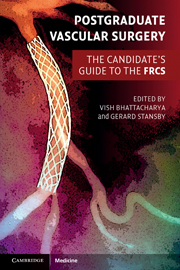Book contents
- Frontmatter
- Contents
- List of contributors
- Preface
- Section 1 Final FRCS vascular clinicals
- Section 2 Final FRCS vascular topics
- 1 Vascular risk factors and their management
- 2 Management of acute limb ischaemia
- 3 Chronic lower limb ischaemia, critical ischaemia and the diabetic foot
- 4 Endovascular and surgical options for peripheral revascularisation
- 5 Abdominal aortic aneurysms
- 6 Thoracic, thoracoabdominal and suprarenal aortic aneurysms
- 7 Aortic dissection
- 8 Popliteal artery aneurysms
- 9 Femoral artery aneurysms
- 10 Carotid, subclavian and vertebral disease
- 11 Diagnosis and management of thoracic outlet syndrome
- 12 Diagnosis and management of hyperhidrosis
- 13 Chronic mesenteric ischaemia
- 14 Acute ischaemic colitis
- 15 Vascular trauma
- 16 Indications and management of lower limb amputation
- 17 Leg swelling and lymphoedema
- 18 Varicose veins and chronic venous insufficiency
- 19 Management of deep vein thrombosis
- 20 Infection in vascular surgery
- 21 Vascular malformations
- 22 Vasospastic disorders and vasculitis
- 23 Critical care considerations and preoperative assessment for general and vascular surgery
- 24 Access surgery
- 25 Basic outline of solid organ transplantation
- Index
- References
4 - Endovascular and surgical options for peripheral revascularisation
- Frontmatter
- Contents
- List of contributors
- Preface
- Section 1 Final FRCS vascular clinicals
- Section 2 Final FRCS vascular topics
- 1 Vascular risk factors and their management
- 2 Management of acute limb ischaemia
- 3 Chronic lower limb ischaemia, critical ischaemia and the diabetic foot
- 4 Endovascular and surgical options for peripheral revascularisation
- 5 Abdominal aortic aneurysms
- 6 Thoracic, thoracoabdominal and suprarenal aortic aneurysms
- 7 Aortic dissection
- 8 Popliteal artery aneurysms
- 9 Femoral artery aneurysms
- 10 Carotid, subclavian and vertebral disease
- 11 Diagnosis and management of thoracic outlet syndrome
- 12 Diagnosis and management of hyperhidrosis
- 13 Chronic mesenteric ischaemia
- 14 Acute ischaemic colitis
- 15 Vascular trauma
- 16 Indications and management of lower limb amputation
- 17 Leg swelling and lymphoedema
- 18 Varicose veins and chronic venous insufficiency
- 19 Management of deep vein thrombosis
- 20 Infection in vascular surgery
- 21 Vascular malformations
- 22 Vasospastic disorders and vasculitis
- 23 Critical care considerations and preoperative assessment for general and vascular surgery
- 24 Access surgery
- 25 Basic outline of solid organ transplantation
- Index
- References
Summary
Key points
Risk factor optimisation and best medical therapy are the standard of care for all patients
Severe acute ischaemia is best managed with surgery, there is a role for thrombolysis in less severe cases
Thrombolysis requires intensive monitoring to identify and manage complications
Surgical or endovascular revascularization is appropriate for patients with limiting claudication or critical limb ischaemia
Non-invasive imaging should be used for procedural planning
Bypass grafts with autologous vein produce the best long-term patency rates
Endovascular procedures have lower mortality and morbidity rates than the equivalent surgery
Stents and stent grafts improve endovascular results and are important for managing complications
Patient fitness, co-morbidity and preference are as important as lesion characteristics in informing revascularization decisions
Multi-disciplinary teams are best placed to manage individual patients in this rapidly evolving field
Background
Many patients with peripheral arterial disease (PAD) do not require any revascularization procedure. Identification and management of modifiable risk factors are effective in reducing the excess risk of cardiovascular mortality and preventing acute limb ischaemia due to disease progression. Also supervised exercise programmes can benefit those with intermittent claudication, a Cochrane review of randomised trials in patients with stable intermittent claudication suggested an improvement in walking distance of 150% with a regime of three sessions per week of walking to near maximum pain.
However, surgical and endovascular revascularization procedures produce substantial additional benefits when proficiently performed upon carefully selected and prepared patients.
- Type
- Chapter
- Information
- Postgraduate Vascular SurgeryThe Candidate's Guide to the FRCS, pp. 72 - 85Publisher: Cambridge University PressPrint publication year: 2011



